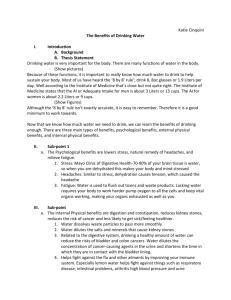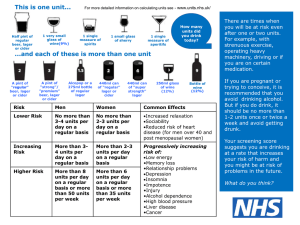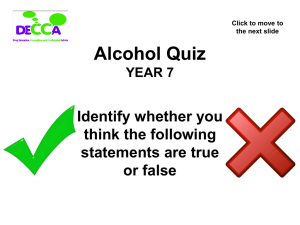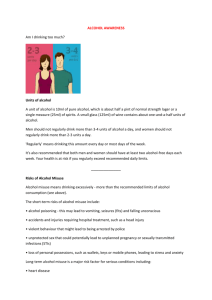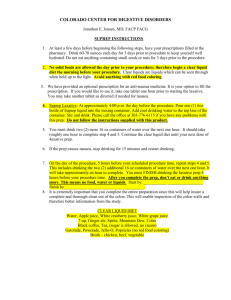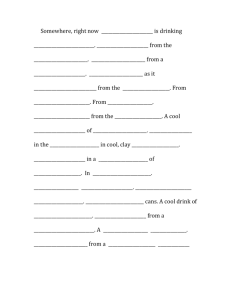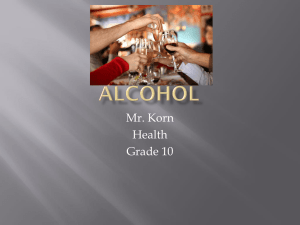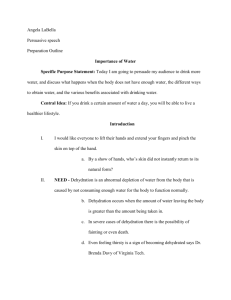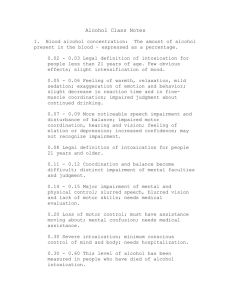Well-being Guide Alcohol
advertisement
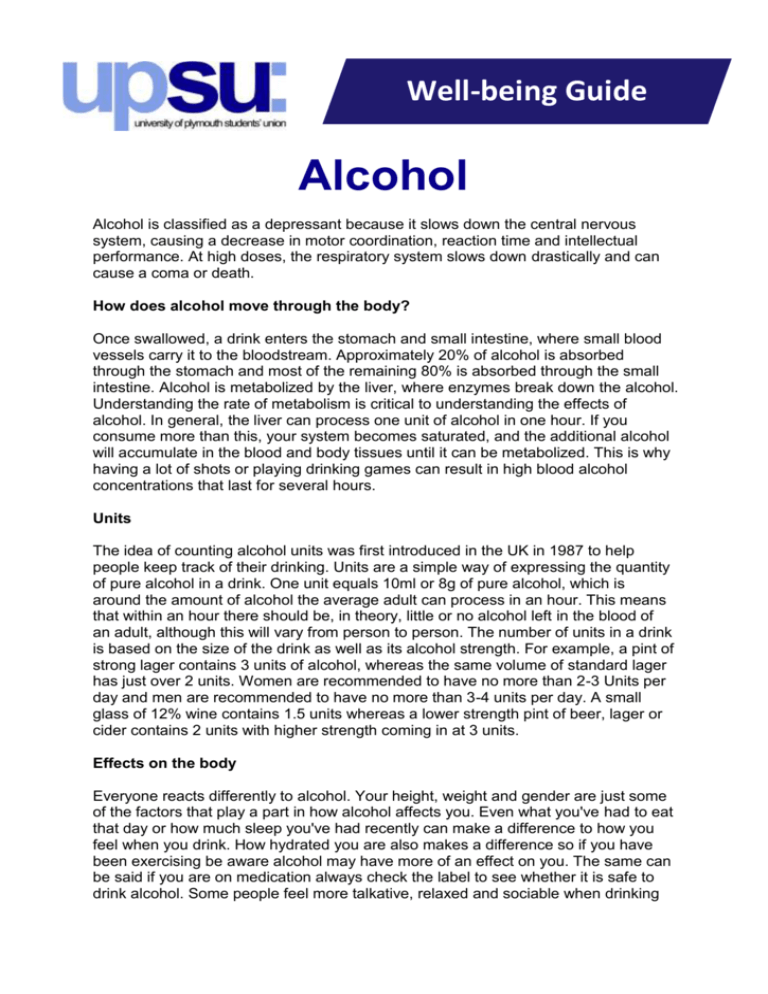
Well-being Guide Alcohol Alcohol is classified as a depressant because it slows down the central nervous system, causing a decrease in motor coordination, reaction time and intellectual performance. At high doses, the respiratory system slows down drastically and can cause a coma or death. How does alcohol move through the body? Once swallowed, a drink enters the stomach and small intestine, where small blood vessels carry it to the bloodstream. Approximately 20% of alcohol is absorbed through the stomach and most of the remaining 80% is absorbed through the small intestine. Alcohol is metabolized by the liver, where enzymes break down the alcohol. Understanding the rate of metabolism is critical to understanding the effects of alcohol. In general, the liver can process one unit of alcohol in one hour. If you consume more than this, your system becomes saturated, and the additional alcohol will accumulate in the blood and body tissues until it can be metabolized. This is why having a lot of shots or playing drinking games can result in high blood alcohol concentrations that last for several hours. Units The idea of counting alcohol units was first introduced in the UK in 1987 to help people keep track of their drinking. Units are a simple way of expressing the quantity of pure alcohol in a drink. One unit equals 10ml or 8g of pure alcohol, which is around the amount of alcohol the average adult can process in an hour. This means that within an hour there should be, in theory, little or no alcohol left in the blood of an adult, although this will vary from person to person. The number of units in a drink is based on the size of the drink as well as its alcohol strength. For example, a pint of strong lager contains 3 units of alcohol, whereas the same volume of standard lager has just over 2 units. Women are recommended to have no more than 2-3 Units per day and men are recommended to have no more than 3-4 units per day. A small glass of 12% wine contains 1.5 units whereas a lower strength pint of beer, lager or cider contains 2 units with higher strength coming in at 3 units. Effects on the body Everyone reacts differently to alcohol. Your height, weight and gender are just some of the factors that play a part in how alcohol affects you. Even what you've had to eat that day or how much sleep you've had recently can make a difference to how you feel when you drink. How hydrated you are also makes a difference so if you have been exercising be aware alcohol may have more of an effect on you. The same can be said if you are on medication always check the label to see whether it is safe to drink alcohol. Some people feel more talkative, relaxed and sociable when drinking responsibly. Some of the negative side effects of short term alcohol misuse include dizziness, sickness, confusion, aggression, low blood sugar, dehydration, headaches, falls, injuries and accidents. Too much alcohol also affects judgement, co-ordination and perception we also suffer from poor quality sleep because the body is busy trying to remove the alcohol from the body. In severe cases drinking too much alcohol can cause breathing difficulties, anxiety, blackouts or unconsciousness. Alcohol & Calories Alcohol- especially beer- is associated with the fat storing hormone cortisol which encourages fat to store around the belly, hence the term “beer belly”. B vitamins are involved in both the processing of alcohol and fat burning therefore we struggle to burn fat efficiently when the body is busy processing large quantities of alcohol. Large amounts of alcohol also hinder the body’s ability to recover from exercise, illness or injury again because your body is busy trying to remove the toxic levels of alcohol. Many drinkers add to their calorie count by having snacks, such as crisps, nuts or pork scratching’s, to accompany their drinks. A heavy drinking session is often followed by an unhealthy breakfast to help cope with a hangover, which again helps to pile on the pounds. Going for a fry-up instead of your usual bowl of cereal can add an extra 450kcal to the calorie count from the night before. A pint of lower percentage beer can contain up to 200 calories which would take the average person 20 minutes to run off. Cocktails can contain high amounts of calories especially those with creams and liquors which can feature anywhere between 150600 calories per glass. Advice After drinking alcohol try to leave at least 48 hours for the body to recover. Keep track of how much alcohol you are drinking weekly. If you feel you are drinking most days try some of the change for life schemes such as planning other alcohol free events. I.e. cinema, exercise etc. Make sure you know your limits, eat well and have plenty of sleep before social situations involving alcohol. Try to alternate alcoholic and non-alcoholic drinks on nights out. Bars should offer free water but be aware some do not. Drinking in rounds can mean you drink more than intended. Drink at your own pace and opt out of rounds. Don’t drink on an empty stomach; not only will alcohol affect you quicker but you are more likely to choose unhealthy food options later on. Pace yourself and set a time limit on when you will stop drinking. Make sure you are hydrated during the day. If you do get a hangover drink plenty of water the next day. Try eating a banana too; they are particularly good due to potassium content, being gentle on the stomach and also containing essential electrolytes which will have been lost while drinking. For more advice on alcohol please contact emma.anderson1@su.plymouth.ac.uk Useful links: Alcohol and its journey through your body Alcohol and your emotions Alcohol and Cancer (link to external site) Emma's Presentation on Alcohol - February 2015
